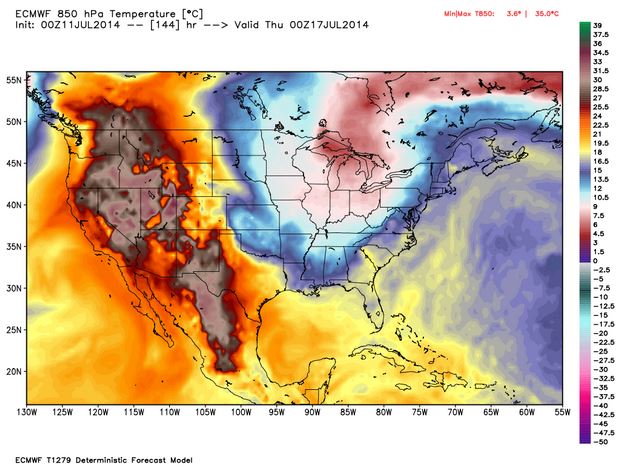The California drought and climate disruption
A particularly wavy jet stream is what is causing the so-called “polar vortex,” or cold air from the Arctic, to travel down to the United States. ClimateProgress covered the jet stream connection on Monday, it will be unseasonably chilly in the eastern part of the United States this week, due to a peculiar weather pattern that’s causing deep waves in the jet stream.
One of those big waves is bringing cool air down from the northeast Pacific and the Arctic. This will cause nighttime temperatures to be, on average, in the 50s or 60s on Tuesday and Wednesday.
So is it the polar vortex, or isn’t it? That’s been the big debate among meteorologists and news outlets. But according to at least one scientist, that debate misses a more important point about the unusual weather pattern sweeping the United States — that it’s causing extreme weather in other parts of the country.


Jennifer Francis, an atmospheric scientist and research professor at Rutgers University, “We’ve got this cool air coming down over the eastern half of the country, and that’s gonna just be kind of nice, but along the east coast, we’re looking at storms and floods. On the west coast, we’re looking at heat and fires. And it’s all part of this jet stream pattern.”
A particularly wavy jet stream is what is causing the so-called “polar vortex,” or cold air from the Arctic, to travel down to the United States, Francis said. The dramatic and unusual southward swoop, shown in the map on the right, allows air from the cold north to travel south.
The same thing happened this past January, when a dramatic southward swing of the jet stream brought increased cold air to an already-freezing region. That was big news, extreme weather-wise.
Related
- WTF, Summer? It’s 103 Degrees in Canada, 55 in Missouri
- Storms Get Headlines, but Drought Is a Sneaky, Devastating Game-Changer
- The Weather in U.S. and Canada Will Be Very Bizarre This Week
- Nestlé calls world’s water scarcity ‘more urgent’ than climate change – as it sells bottled water from drought-ridden California
About the Author: CLIMATE STATE
POPULAR
COMMENTS
- Robert Schreib on Electricity generation prices may increase by as much as 50% if only based on coal and gas
- Robert Schreib on China made a historic commitment to reduce its emissions of greenhouse gases
- Lee Nikki on COP30: Climate Summit 2025 – Intro Climate Action Event
- Hollie Bailey on Leaders doubled down on fossil fuels after promising to reduce climate pollution
- Malcolm R Forster on Mythbusters tests global warming theory – does CO2 warm air?